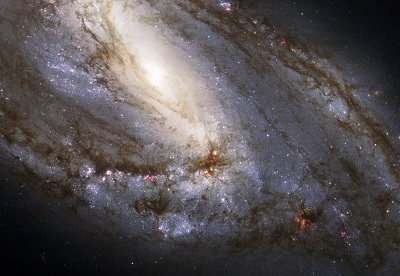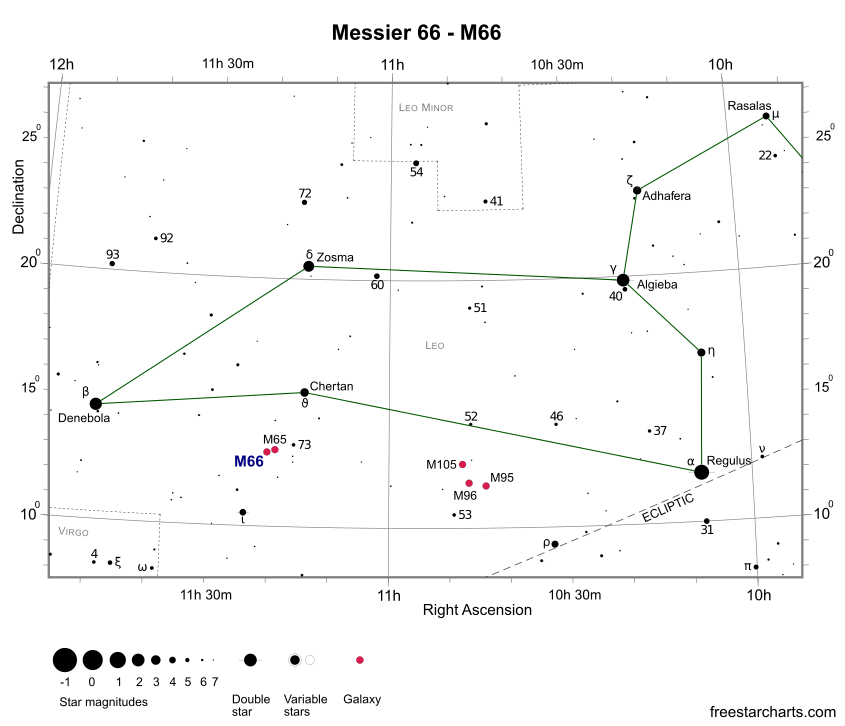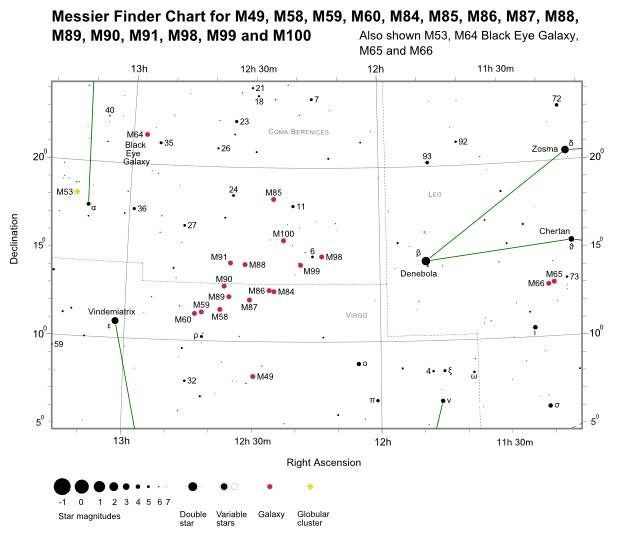M66 is a superb bright intermediate spiral galaxy located in the constellation of Leo. It's the brightest of a trio of galaxies that forms - along with M65 and NGC 3628 - the well known and popular Leo Triplet or M66 group. All three objects can be observed with small telescopes in the same low power field of view. After the M81/M82 pair in Ursa Major, the Leo Triplet is arguably the next most sought after galaxy grouping for amateur astronomers.
Charles Messier discovered both M66 (mag. +8.9) and M65 (mag. +9.6) on March 1, 1780. The apparent magnitude of the third member of the triplet, NGC 3628, is unclear. Some texts record it as the brightest group member, while others have it as the faintest. For our purposes we estimate NGC 3628 to be brighter than M65 and almost as bright as M66. However, what is clear is that it suffers from a low surface brightness and therefore is the most difficult member of the trio to spot. Messier missed it completely and it was not until April 8, 1784 when it was finally discovered by William Herschel.
To find the triplet, look to the eastern part of Leo. This zodiac constellation is relatively large and bright and somewhat looks like the Lion that it's supposed to represent. The brightest star in Leo and its only first magnitude star is Regulus (α Leo – mag +1.4). Positioned approximately 16 degrees northeast of Regulus is Chertan (θ Leo - mag. +3.3). Along with the Zosma (δ Leo - mag. +2.6) to the north and Denebola (β Leo - mag. +2.1) to the east, Chertan forms a prominent right-angled triangle. Located 2 degrees south of Chertan is 73 Leonis (mag. +5.3). M65 lies 0.75 degrees east of this star with M66 a further 0.33 degrees southeast of M65. NGC 3628 is positioned 0.5 degrees north of the Messier pair.
The galaxies are best seen during the months of March, April and May.


Finder Chart for M66 - pdf format (credit:- freestarcharts)

From a dark site, M66 along with M65 are faintly visible with 7x50 or 10x50 binoculars as fuzzy patches of light. Through larger 20x80mm models or a small telescope, M66 appears as a thin oval smudge of light with a brighter centre. Since the pair are only separated by 20 arc minutes of apparent sky they both fit neatly in the same low magnification field of view.
A medium size telescope of the order of 150mm (6-inch) aperture shows M66 as a slightly edge on silvery disk of light with a bright stellar like nucleus. A larger 250mm (10-inch) scope reveals a bright centre wrapped in a faint halo of nebulosity, that hints at the spiral structure. For comparison, M65 appears fainter and more edge on when compared to M66. In total, M66 spans 9.1 x 4.1 arc minutes of apparent sky. At a distance of 36 million light-years from Earth, this corresponds to an actual diameter of 95,000 light-years. The galaxy is estimated to contain about 200 billion stars.
So far, four supernovae have been recorded in M66 (1973R, 1989B, 1997bs and 2009hd). The brightest of which was 1989B, which reached magnitude +12.2 on February 1, 1989.
M66 Data Table
| Messier | 66 |
|---|---|
| NGC | 3627 |
| Object Type | Intermediate spiral galaxy |
| Classification | SAB (s) |
| Constellation | Leo |
| Distance (light-years) | 36 Million |
| Apparent Mag. | +8.9 |
| RA (J2000) | 11h 20m 15s |
| DEC (J2000) | +12d 59m 28s |
| Apparent Size (arc mins) | 9.1 x 4.1 |
| Radius (light-years) | 47,500 |
| Number of Stars | 200 Billion |
| Notable Feature | Member of the Leo Triplet along with M65 and NGC 3628 |